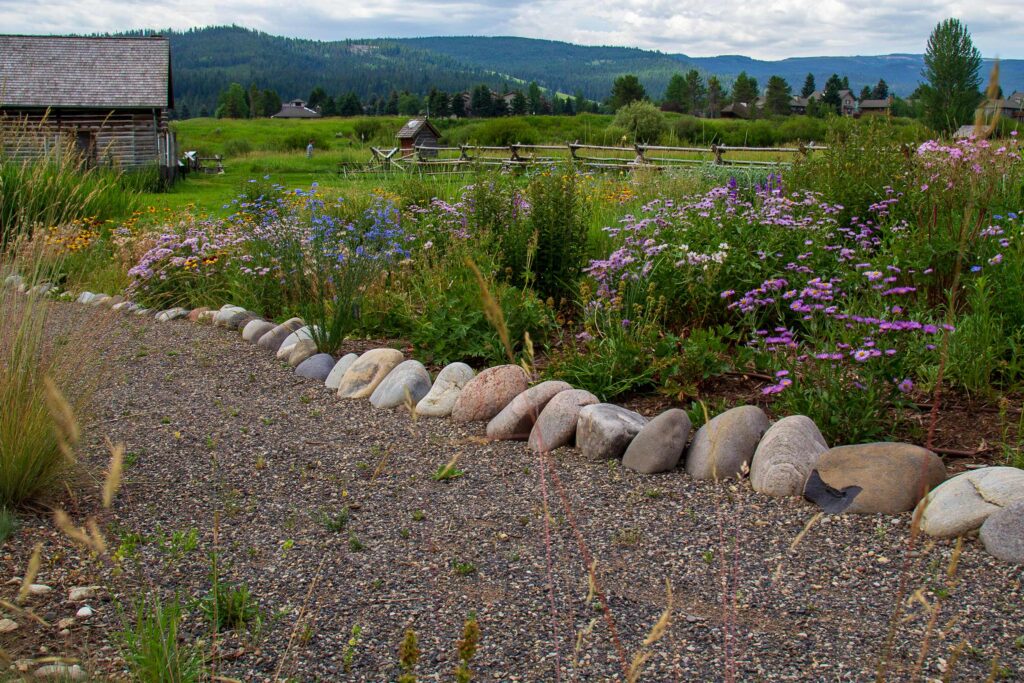Interested in a FREE site visit from one of our partners to answer your questions? Book Now
Protect your home and neighborhood from wildfire threats with fire-resistant landscapes that are easy to maintain, reduce water use, enhance safety and look amazing.
Learn how water-wise solutions can help you conserve water, reduce your bills, and sustain your landscaping – and keep your yard looking well-loved – even in drought conditions.
Not sure where to start? Outlined below are the clearly established firewise guidelines that also incorporate water-wise, native and sustainable design elements.
Establish or evaluate your landscaping through the lens of the Home Ignition Zone (HIZ), the area around your property, divided up into three zones, including any structures, vegetation, and flammable material that can cause your home to ignite during a fire.

Landscape with low-growing, well-spaced native and drought-tolerant plants that are regularly pruned to remain lean and green.
Choose native species that are both beautiful and offer an array of benefits including being crucial for ecological health, enhancing property values and reducing maintenance costs. They also enhance biodiversity, improve air quality, and combat pollution in our water sources.
Avoid unnecessary disturbance to soils to minimize weed germination.
Add additional hardscape elements like patios and boulders, and break up slopes with rock terrace gardens.
Minimize lawn areas to reduce water usage, and limit lawns to flat areas for efficient irrigation.
Try native shrub borders for hard-to-irrigate or narrow areas.
Add mulch to provide a protective cover that moderates soil temperature, and holds in moisture and prevents weeds from reaching the surface.
Remove all dead plant material and thin vegetation to reduce density, and ensure adequate space between all shrubs and trees to mitigate spreading and crown fires.
Choose native vegetation in this zone that’s low or moderately flammable.
Consistently check your property to catch and manage new weed growth.
Looking for more info on Firewise safety? Check out Big Sky Fire’s website.
Proper plant spacing is imperative to designing a landscape that is fire-resistant, water-efficient and ecosystem-friendly. Consider the following for spacing within your landscape:
Leave 10-15 feet between tree crowns with increased spacing on slopes or areas with high winds to reduce the chance of fire jumping from one tree to another.
Keep a minimum of 5 feet between shrub clusters. Adjust distance based on height and growth habits of shrubs.
Prune tree branches to create a clearance of 6 to 8 feet from the ground to prevent ground fires from climbing into tree canopies.
Group plants with similar water needs to create hydrozones for watering that meets the specific needs of each plant group.
For details on specific spacing between plants, download the Alpenscapes Landscaping Guidelines.



The water supply in Big Sky is influenced by a variety of interdependent factors. Each component plays a critical role in water availability and the quality of our drinking water.
1.) Climate Variability
2.) Seasonal Snowpack
3.) Geographical Features
4.) Population Growth
5.) Agricultural Demand
Understanding these influences is essential for developing effective water management and sustainable landscaping strategies.
A healthy soil base is a key to a water-wise landscape. Two important factors that influence how soils store water are soil texture and organic matter. Learn more about how water naturally moves through your soil to help you improve soils and support plant growth.
Want more information on Big Sky soils? Download the Alpenscapes Landscaping Guidelines below.
Detailed information on everything from how to get started to how to maintain a thriving fire-safe, water-wise and ecosystem-friendly Big Sky landscape.
Interested in a free site visit from one of our partners to answer your questions?